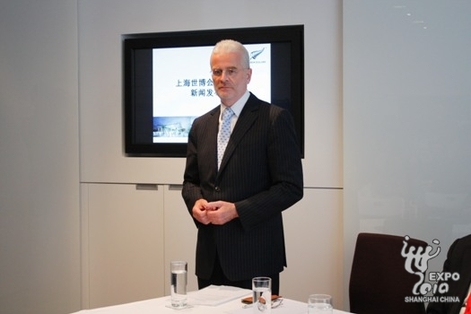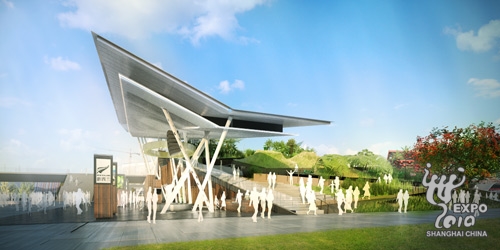New Zealand's team finally unveiled the country's Expo 2010 pavilion's exhibition design - a dream-like journey about the Maori story of creation.
|

Phillip Gibson, New Zealand commissioner general for the Expo, talks about the pavilion's design. [expo2010.cn]
|
The pavilion's theme, "Cities of Nature: Living between Land and Sky," was inspired by the Maori creation story of Tane (the forest god), who separated his parents Rangi and Papa (Sky Father and Earth Mother) to create the world in which we live.
Architecturally, the wedge-shaped pavilion extends the story into a three act play – the welcoming space (plaza), the interior, and the rooftop garden, said Dean Cato, director of Story Inc, creator of "The Lord of the Rings" international touring exhibition.
The dream team of New Zealand's award-winning designers comprises Story Inc, Plan 9, the music composer for "The Lord of the Rings" trilogy, and Kim Jarrett, greens master for King Kong.
Through a wide range of artistic and aesthetic devices including screen towers, soundtracks and garden greenery, the titans of New Zealand's film industry are bringing to life the Maori story reprised in modern New Zealand "cities of nature."
The heart of the pavilion is a 1.8-ton pounamu (jade) boulder.
"We invite visitors to come and touch the precious stone," said Phillip Gibson, New Zealand commissioner general for the Expo.
|
 an artist's rendition of the pavilion
an artist's rendition of the pavilion
|
"As visitors touch the precious stone, they will be touching the heart of New Zealand."
The pounamu symbolizes the convergence of two jade cultures, as the Chinese and indigenous Maori of New Zealand share a common reverence for jade.
The welcoming space in front of the pavilion is a physical manifestation of Rangi and Papa. The white canopy in the plaza representing Sky is supported by white pillars that represent a vertical forest. It is erected on the forecourt that symbolizes Earth.
Starting with a little girl's dream of Rangi and Papa when dawn breaks in her bedroom at Auckland Harbour, visitors will touch upon some common scenes in New Zealanders' life.
The chronological journey starts at dawn and ends at dusk, traversing the seasons from spring to winter and moving along various landscapes from the sea to the mountain, with suburbs and cities in between.
Walking along the gently sloping walkway, visitors will see the girl's mother making breakfast in a beach house, the girl drawing her dream at school and the girl's father at work. The final station is a New Zealand house in the hillside, where the girl is showing her parents and grandparents her drawing of the creation story.
This "day-in-the-life" journey is beautifully complemented by a rhythm soundtrack across the entire interior of the pavilion and melody soundtracks along each of the five stations. The soundtracks are composed by New Zealand's award-winning Plan 9, which composed the music of "The One Ring" for "The Lord of the Rings" trilogy.
The pavilion's rooftop garden is designed by Dawnfinder, New Zealand's renowned design duo of Kim Jarrett and Tina Hart specializing in gardens and landscapes. Jarrett was the greens master for "King Kong," constructing prehistoric jungles, swamps, and coast lines for the movie shot in Wellington.
There will be the Gondwanaland in the garden. The land was first created by the separation of Rangi and Papa at the dawn of time, and will feature ponga (tree ferns) shipped from New Zealand.
Visitors will then walk by a thermal lake, which is common in the Rotorua region in the North Island of New Zealand. Mist, steam, and air cannons will create the illusion of hot water bubbling in the thermal lake, which is from the korokoro (throat) of Ruaumoko, the youngest son of Rangi and Papa and the god of the underworld, according to the Maori myth.
Walking down the pathway visitors will encounter the forest valley and the South Pacific Sanctuary, featuring a planted arbour that uses Maori weaving techniques,
The pathway will end with a Pohutukawa tree. The Pohutukawa tree, which blooms with red flowers in December, has become synonymous with the New Zealand Christmas.
The budget of the pavilion is US$25 million.

